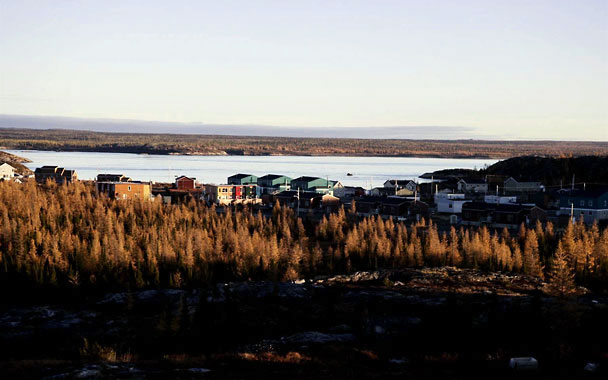I arrived in Kuujjuaq, 900 miles north of Montreal, to report a story on Arctic tourism. I would be there for the summer and was eager to sample the local fare. Unfortunately the only two restaurants in town specialized in cheese fries and pizza. The “country food,” I learned, is not eaten out, but in the home.
While I was photographing kids in my new neighborhood one morning a woman shouted to me from her porch, “Come take a picture of me!” Her name was Winnie, and she was from a town called Great Whale. She had spent the past ten years in Kuujjuaq, working at a local nonprofit. Within minutes I had met her sister, brother, daughter and granddaughter. The following day she uttered the words I’d been waiting for: “Wanna try seal meat?”
Thawing atop a piece of cardboard on her kitchen floor was a hunk of seal the size of a small suitcase. Some parts were still frosty from the freezer, other bits moist and gleaming. Winnie deconstructed the carcass: Blotches of brown were meat; the bright red bits, blubber; and the purple stripe across the center was the liver.
“The best part is the flipper,” said Winnie. “I like the eyes too.”
“My favorite is liver,” said her daughter, and sliced off a raw sliver with an ulu, a traditional knife curved like a crescent moon and clenched in the palm like a pizza cutter. She dipped it in seal oil, as you might dip a bit of lobster in melted butter, and handed the piece to her one-year-old daughter.
In a pan beside the seal was a baked caribou leg. It was dark, tender, and delicious. Of the seal I only had a half-frozen purple shred, but the taste was immense: salty, smooth like sushi, and imbued with a scent of sea so strong I felt as if I were eating ocean. Winnie planned to boil the seal in a pot and invited me back for dinner.
Kuujjuaq is the largest town in Nunavik, a region in far northern Quebec the size of France. Most of Nunavik’s 10,000 residents are Inuit. They live in heated homes and work office jobs but keep their native traditions alive by hunting food from the land. When caribou graze outside town in late summer, offices empty. Beluga and walrus kills are announced on local radio stations, and communal freezers, like the one Winnie’s had come from, store meat for residents. I was lucky—it was the first time that year the family had feasted on seal.
In the U.S. we balk at eating marine mammals hunted in the wild, especially cute furry ones like seals, but up here it is common, and consuming a penned chicken or a hormone-pumped cow seems outrageous.
Come dinnertime I could smell the seal from the street, like the pungent odor of a fish market. Winnie laid boiled seal ribs on a platter, adding a dab of ketchup on the side. “Inuit love ketchup,” she said.
We gnawed every last bit from the bone. The meat was soft and somewhat rubbery, not as tender as pork, but again steeped with that satisfying hint of the sea.
“Do you want to try the brain?” asked Winnie.
She fished a white dab from an oblong spike of upper spine and passed it to me on her finger.
“You’re a guest,” said her brother. “You should try.”
It was squishy and rich, like a well-ripened avocado.
“How is it?” asked Winnie. “Creamy?”
“Creamy!” I confirmed.
A week later I broke down and entered one of the local restaurants, craving French fries. I was surprised when Winnie and her family walked in. Her grandkids ordered 7 UPs and poutine (fries smothered in gravy and cheese), and her daughter got a burger. Winnie just had coffee.
“Not hungry?” I asked.
“I don’t eat that stuff,” she said.
But I did notice her eyeing the ketchup packets.



 Pinterest
Pinterest


